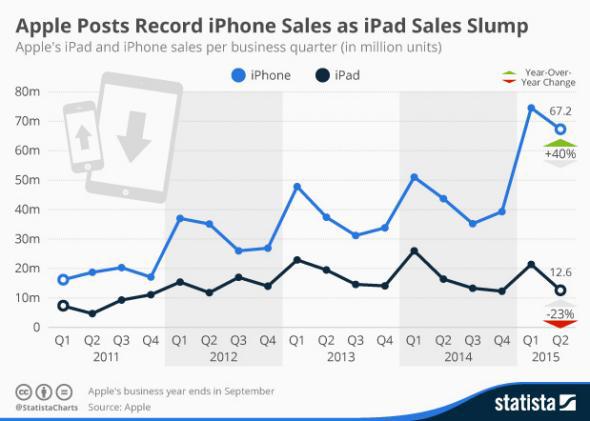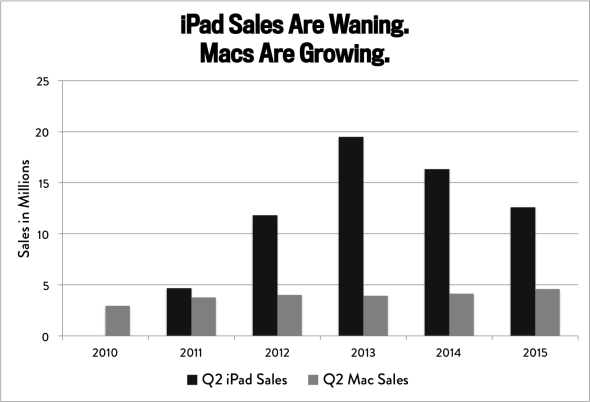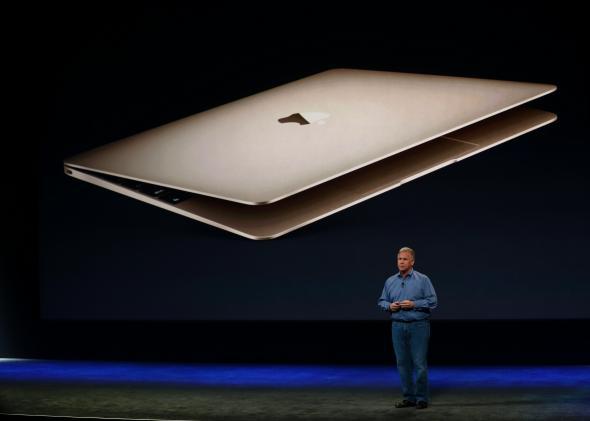Apple is riding higher than ever, thanks to soaring iPhone sales, especially in China. Demand for the Apple Watch has been intense, and the company is making more money than ever from its App Store.
There was just one piece of bad news for the company in Monday’s otherwise glowing earnings report: iPad sales are down—again. Apple sold just 12.6 million of its sleek tablets in the first three months of 2015, down from 16.4 million in the same quarter a year ago. The disappointing figures continued a slump that has worsened over the past year. I examined some of the forces driving down iPad sales in a column last year in which I asked whether, at the tender age of 4, Apple’s tablet had already passed its peak.
The conventional wisdom is that the iPad’s sales have been hurt by a trend toward larger smartphones, including Apple’s own iPhone 6 and iPhone 6 Plus. Analysts on Monday were quick to contrast the iPad’s decline with the seemingly endless growth in iPhone sales. You can see the gradual decoupling in this chart from the German statistics portal Statista.

Courtesy of Statista
No doubt some consumers are opting for generously sized new iPhones rather than iPads. But that can’t be the whole story. After all, the iPad’s woes significantly predated the arrival of the 6 and 6 Plus. I’ve long suspected that the squeeze is coming not just from smartphones, but from computers—in particular, Apple’s own ever-slimmer, ever-lighter MacBook line.
Monday’s earnings brought the strongest evidence yet for this hypothesis.
In the same quarter that iPad sales sank to three-year lows, Mac sales grew by a surprising 10 percent year over year. That’s especially impressive when you consider that, as Apple CEO Tim Cook emphasized Monday, sales of all PCs worldwide were down an estimated 7 percent in the same time period.
The strong numbers continue a trend of quiet Mac sales growth that has neatly coincided with the iPad slump. Below, courtesy of Slate Moneybox blogger Alison Griswold, is a chart comparing second-quarter iPad sales and second-quarter Mac sales each year since 2010, when the iPad was introduced. (Quarterly sales data prior to 2015 are courtesy of Statista, whose own recent charts of Mac and iPad sales you can find here and here.)

Chart by Alison Griswold/Slate. Sales figures drawn from Apple and Statista.
As you can see, second-quarter iPad sales peaked in 2013, the same year that Mac sales hit a nadir. In the two years since, Mac sales have rebounded in tandem with iPad sales’ recession. You can see the trend even more clearly when you look at year-over-year growth for both product lines. (Again, the chart uses only data from the second quarter of each year, for consistency’s sake, but you’d find broadly similar trends if you looked at other quarters, or at annual figures.)

Image by Alison Griswold/Slate
Until now, Apple has been reluctant to acknowledge that the downward trend in iPad sales is much more than a blip. That changed Monday, when Cook addressed the issue directly in a phone call with investors and media. For the first time that I’m aware of, he pointed to Mac sales as well as iPhone sales as major factors in the iPad’s relative doldrums.
“Have we had cannibalization?” Cook asked rhetorically, referring to the idea that sales of other Apple devices have cut into the iPad’s fortunes. “The answer is yes. We’re clearly seeing cannibalization from the iPhone, and on the other side from the Mac.”
But that doesn’t mean the iPad’s days are numbered, Cook insisted. “We’re never worried about that,” he said of the cannibalization. “It is what it is. That will play out, and at some point it will stabilize. I’m not precisely sure when, but at some point it will.” Underwhelming sales numbers aside, Cook added, customer satisfaction with iPads remains high, and a healthy portion of iPad buyers are first-timers, suggesting that the market remains unsaturated. iPad sales in China are also on the rise, along with Mac and iPhone sales.
In the meantime, Apple is banking on a big deal with IBM to supply iPads to large business customers as a way to resuscitate the tablet’s popularity. That might work, although it would also mark a rare transition for an Apple product from coveted consumer gadget to humdrum workplace staple. And the iPad is likely to face heavy sales pressure in the enterprise market, not to mention resistance from an IT workforce that still breathes Windows.
All that said, I actually believe Cook when he says the company is not too concerned about Mac sales eating into iPad sales. After all, Macs are more expensive than iPads, and Mac revenues actually exceeded iPad revenues in the most recent quarter. As long as the iPad continues to outpace rival companies’ tablets—which it has—Apple will keep raking in profits one way or another.
Two or three years ago, all the pundits were predicting the tablet would soon kill the personal computer. I’ve always been skeptical of that narrative, although it has become something of a self-fulfilling prophecy in the PC world, where trend-chasing hardware manufacturers have largely given up on making great laptops. Apple has not, and the result has been surprising resilience in demand for its MacBooks. Its latest, the ultra-light 12-inch MacBook, went on sale earlier this month, and Cook said Monday that the company is “very happy with the response” from consumers. The iPad may not be dead, but neither is the personal computer—and right now, for Apple, they’re heading in different directions than everyone expected.
Read more in Slate:
